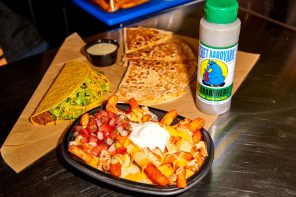The Roy Smith Memorial Catering Competition is an Inter-District Catering competition held annually among the New Zealand Defence Force. The competition challenges chefs and stewards alike in a gruelling two-day barrage of written examinations, knife skill tests, equipment identification, tablecloth and napkin folding, fruit cutting, barista and bartending skills, as well as a seven-course meal presented to some of the most reputable chefs in New Zealand.
This year, the 42nd Roy Smith event was competed for between five teams. Appearing in their first year of competition, the Australian Defence Force Joint Logistics Command team arrived in Waiouru, as well as second-time competitors, the 524th Combat Sustainment Support Battalion, 25th Infantry Division, from Hawaii (Team Hawaii), the Royal New Zealand Navy team, as well as the 2nd Combat Service Support Battalion (2CSSB) and the reigning champions, the 3rd Combat Service Support Battalion (3CSSB).
Roy Kenneth Smith joined the Army in 1971 and was quickly promoted to Lance Corporal in September of 1974. Smith had served as part of the 1 Ranger Squadron, as well as the Central Company of the Wellington Platoon. In 1976, Smith was tragically killed in a train accident. Upon his death, financial support for his funeral services was so significant that there was a large sum remaining afterwards. It was unanimously decided that a Rose bowl and miniatures were to be purchased and presented to the Corps for an Inter-District Catering competition as a memorial to Lance Corporal Smith. The first instance of the competition was held in 1977 and was appropriately won by Central Company, Smith’s last unit. Since then, the competition has remained mostly unchanged and is highly sought after in the NZDF catering services.
The second day of the Roy Smith Competition started early. Magic Box ingredients were revealed to the teams at 8 am. The Magic Box was a container of mystery ingredients that were unknown to the competitors before their reveal. Greytown Honey sponsored this year's Magic Box, and the compulsory ingredients were honey and goat, which had to be used in the starter dish. In addition, Akaroa Salmon was also a sponsor, and entrée dishes had to use salmon. As one of the kitchen judges, Glen Fulcher, would later say, "Goat is one of the harder proteins to work with—cooking methods are vital to get right.”
While chefs completed their tasks, the stewards were being tested on their level of expertise in cocktails, table setting, napkin folding, and fruit cutting. Through these challenges, it was easy to see the commitment and dedication that each one of these contestants had devoted to the Roy Smith Competition. As expected, rigidity and structure were apparent in every aspect of the cooking and stewarding tasks. The stewards laboured over folding tablecloths with expert precision and chefs delicately used tweezers to arrange their food on the plates.
Clipped to each team’s station were their timings and instructions that they had laid out before cooking—these were the most critical asset for each team that detailed their strict windows of timing. However, unexpected changes were not awry. At one stage, fat from a pork dish in the Australian kitchen dripped into the oven and caused a small fire. The Australian team handled the setback with immense calm and were able to carry on serving moments after the entire kitchen had been engulfed in smoke.
Teams’ progress began to stagger. 3rd Combat Services Support Battalion and the Royal New Zealand Navy teams were serving desserts while other teams were still plating and serving mains. Some of the standout main meals included 2 CSSB’s ‘Smoked pork fillet and pulled pork croquette served on kumara puree with kumara ravioli, bok choy pesto, pickled petit leafs, glazed ginger carrots and an Asian infused jus’, as well as the Australian Defence Force team’s ‘Marinated pork shoulder with cavolo nero in a tomato coulis, blistered cherry tomato, coconut potato puree and glazed kumara’.
As the final courses were served, the chefs and stewards were finally able to take a breath and reflect on their day.
“If an army runs on its stomach,” said Training and Doctrine Command New Zealand chief of staff Lt. Col. Tim Marsden, “Then they’re going to have a hard time given the quality of all of this delicious food.”
The competition also showcased the comradery between each team and the Corps as a whole. U.S. Army Lt. Col. Julio Colongonzalez said, “It truly showcased interoperability. The competition was fierce but friendly. We look forward to working with our allied nations soon.” Additionally, Spc. Markowen Casares, also from Team Hawaii, said, “It’s definitely something that has brought us closer together and gave us the opportunity to build lasting friendships with our partners overseas.”
The Awards Ceremony were held later in the evening. The judges announced the winner of the 42nd Roy Smith Competition as 2 CSSB. Individual dish prizes were given out, each team being well represented for their different dishes. Lt. Col. Marsden said, “It takes an incredible amount of energy to prepare and serve fine dining, but you all have taken it to the next level by choosing to be judged on how you’ve done.”
While the Roy Smith Memorial Competition is a great way to showcase the finely-honed skills of the support services, it is not the only catering competition the army has. Just a few weeks ago, the Operational Cup was competed, this time just between 2 CSSB and 3 CSSB. The Operational Cup is about cooking in the field. Teams are tasked with setting up and running a field kitchen to cater to the grittier side of catering for the army.










